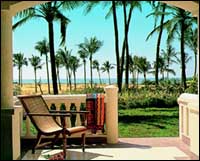


 The Taj Group of Hotels has acquired a new property, the Taj Exotica, off the Benaulim beach, that is a lovely 56-acre luxury resort, discovers Edward H. Phipson.
The Taj Group of Hotels has acquired a new property, the Taj Exotica, off the Benaulim beach, that is a lovely 56-acre luxury resort, discovers Edward H. Phipson. |
|
The cottages at the Taj Exotica, deep in the unexplored South Goa, are like little mansions. You sit in your own private verandah, in Parsi armchairs, reading the O'Heraldo and watching the garden sprinklers laundering the green turf. There are baby palms everywhere, and plants and hedges that are pushing out of the earth; it will take a monsoon or two before everything grows and blooms in this lovely 56-acre luxury resort, 45 acres of which are generously expended on landscaping. The Exotica is spread out on a bluff of land and the sea rolls below it on a beach with the whitest sand I have seen this side of the Pacific. It is a virgin beach, untrampled by footprints in the sands of time.
Around 8 p.m., I take an easy-go kart, battery operated and running soundless through the parkways, to the main hotel building. It has a large foyer that runs across the length and breadth of the square building, under an open sky, and in the centre a fountain throws up endless jets of water, somewhat belligerently. At lunchtime, it has to be turned off so that the piano-player in the lobby may be heard. But this is dinnertime and I head for the Mediterranean restaurant at the far end of the lobby, managed by Sous Chef Dinesh Kapri. He has been given a free hand by Executive Chef Bernard Koeing, and I must say he is doing a good job of it. I am amazed at the number of young chefs that the hotel industry has suddenly thrown up, confident, committed, with sound techniques and innovative minds. Truly it is the profession of the new century. But the old chefs have not been forgotten and that is the nicest part of this restaurant. The Taj, in a grand display of gratitude and admiration, has named the restaurant after its own famous and almost legendary chef, the late Miguel Arcanjo Mascarenhas, known to three generations of diners at the hotel's flagship in Bombay as Masci. He joined the Taj as a 16-year-old, direct from a Goan village, and, though untutored in catering institutions, he grew to be "the greatest Oriental artiste of Occidental viands", ruled over the Taj kitchens for 60 years, cooked for kings and presidents, and was J.R.D. Tata's favourite cook.
Miguel Arcanjo is built on the lines of a Mediterranean restaurant, in Athenian white, the Salcete sunlight streaming in. There is a balcony fanned by the sea, and an air-conditioned main dining hall, with an open counter kitchen at one end. Most of the food is cooked here, in public view, the grilling, pan-frying, building the salads, sweating the pizzas in the ovens, crowding the restaurant with the gentle aromas of food cooking in virgin olive oil. On the counters are wide-necked jars of olive oil, seasoned with fresh herbs, bay leaf, oregano, thyme, parsley, basil, sage, and mushrooms, chives, old red chillis, black olives and black pepper corns, to make the oils more fragrant.
On individual tables, the steward places decanters of wine vinegar and extra virgin olive oil, and an unusual dip of capsicum and parsley, made from roughly chopped capsicums cooked in olive oil, chopped onions, tomato, garlic, white wine vinegar, soft bread soaked in it, and crushed black pepper. I try the foccacio bread, a restaurant favourite, with the dip. The taste is sharp and tangy with the sun dried tomatoes in the composition of the bread, like civilised horse radish. Every Italian restaurant you go to, you learn new tricks, and the Miguel Arcanjo is half Italian.
The other half has dishes from the countries abutting on the Mediterranean. I go through some of them with Chef Kapri. The paella and the red snapper soup are from Spain, the pastas and soft wet pizzas naturally from Italy, the salad with the strong feta cheese from Greece, the mezze with hummus from Lebanon, the seared tuna and the duck breasts with eggplant from Turkey, the lamb stew with pumpkin and chick peas from Morocco. Even in the desserts, the mocha and chocolate chip parfait are from France, mixed berries from Spain, tiramisu from Italy. And all the ingredients are imported, everything, except the fish, the seafood, that's local, direct from the ocean that washes Goa's shores. Naturally.
For starters, there is a tenderloin, marinated in several fresh herbs (thyme, oregano, basil), with a lot of black pepper. It is kept frozen, and, when the order comes, it is sliced very thin and served cold, with lemon juice and olive oil, and more pepper, with flakes of parmessan on top. The salad is the kind I have had in Greek villages, along Homer's wine grey Aegean, from Alexandropoulis to Thesaloniki, with strong feta cheese, black olives, lettuce, done in an edible iceberg lettuce cup. The iceberg lettuce is the sweetest of all lettuces, put it in iced water and it turns crisp. Its sweetness contrasts with the near acrid taste of the goat cheese.
The starter I recommend is the salmon tabbouleh, especially if you are partial to the salmon skin. It is a Lebanese dish, though it is found in most of the Gulf sheikhdoms, Dubai included. The salmon, with the skin intact, is cooked in olive oil, then the skin is removed, stretched on the hotplate and turned crisp. The rest of the fish is mixed with chopped parsley, onions, tomatoes, roughly ground wheat, with lemon juice and garlic. The resultant lemony and garlicky contents are packed in an iceberg lettuce cup, and the skin placed on the top of them. Note, the salmon is still warm when it comes to the table, the rest is cold. There is a dash of balsamic vinegar on the side of the plate. You alternate between taking bites of the salmon skin and scooping out the salmon from the cup.
One more starter and I have done. It is a timbale, a sort of a tower, made of layers of marinated eggplants, basil, fresh tomato sauce, mosarella and parmessan, served on braised pumpkin. For the vegetarians. For all salads and pastas, the restaurant uses extra virgin olive oil. It is the first pressing of the olives, has no grease, and tastes fresh. The colour is a little unappetising greenish, but you don't have to look at the colour.
There are three soups on the menu, including the Provencal, a Spanish fish soup made from a variety of fish that are low in fat, snapper, sardine, mackerel, sole, the head shells of the prawn. They are cooked in fish stock, with vegetables, tomatoes and thyme. Removed, pureed and strained through a colander. And they are served with rouille, which is a bread made with milk and saffron, black pepper and parsley. It is a thick soup, with cream on top. The Gazpacho Andulusion is iced, but I am not for chilled soups, not even in tropical Goa.
Now move to the Spanish saffron risotto, served with a fondue of soft cheeses melted in a double boiler. The fondue is put on the top of the rice, like a gravy, with a lot of fresh crushed black pepper.
|

Home Page
About the mag
Subscribe
Advertise
Contact Us